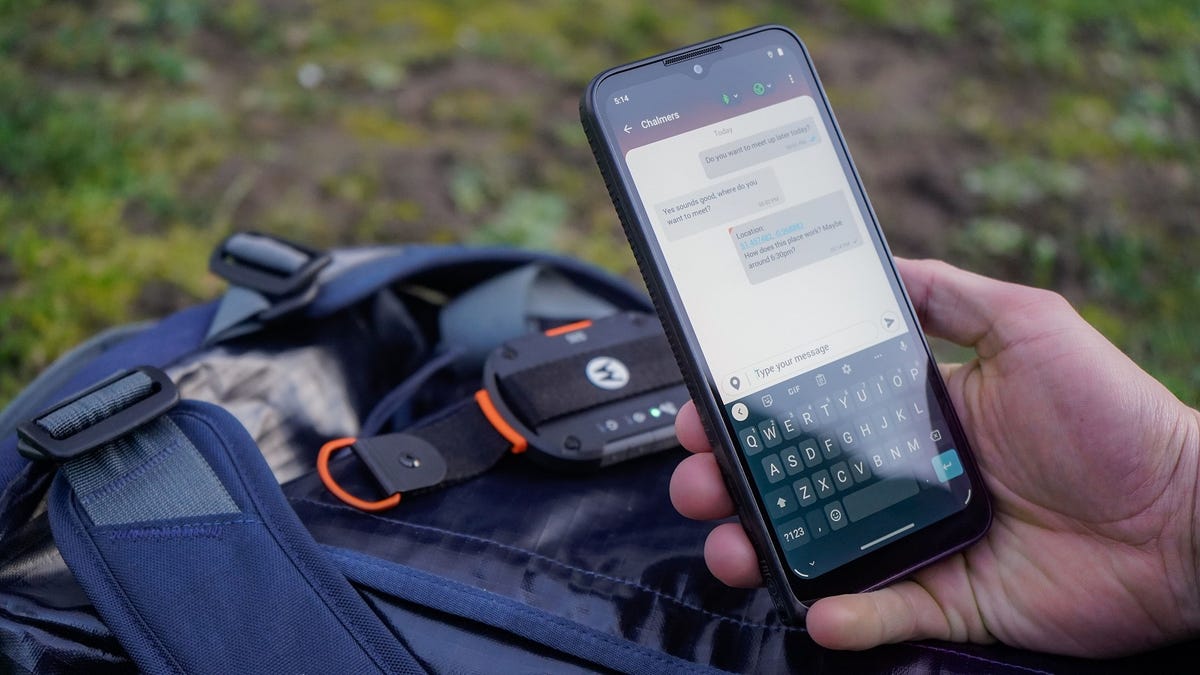Bullitt to Launch Its iPhone-Rivaling Satellite Smartphone in March
The Motorola-branded Defy 2 is the first Android-running satellite smartphone US and European consumers can buy.

The Bullitt Motorola Defy 2 is a standard smartphone that can connect to Bullitt's satellite network service. Laying on the backpack behind the phone is the Motorola Defy Satellite Link, which allows any device to connect to Bullitt's service.
For months iPhone 14 owners have been able to call for help using satellites, but soon Android fans will have their own alternative phone. Rugged smartphone maker Bullitt's upcoming handset, fully revealed at Mobile World Congress 2023, is set to be the first non-iPhone US and European consumers can buy that uses satellite communication.
The Motorola Defy 2, which Bullitt first teased at CES 2023, is a rugged 5G-connecting smartphone aimed at outdoor enthusiasts or distant workers like long-haul truckers -- anyone who spends enough time beyond the range of a cell network. With a price of $600, the phone has comparable specs to other midrange phones, including a 5,000mAh battery, a 50 megapixel camera with an 8 megapixel zoom lens, a 6.6-inch Full HD Plus display and a MediaTek D930 chipset. Unlike other phones, it's designed to survive harsher conditions and to tap into Bullitt's proprietary satellite service network to send text messages, either socially or to ask for help.
Bullitt is also announcing the CAT 75, a slightly different version of the Defy 2 suited for European and African markets, with antennas that tune into wireless bands.
Bullitt's standalone Motorola Defy Satellite Link connects any phone or device to Bullitt's proprietary satellite network service.
And for those who don't want to buy a second phone to use emergency satellite service, Bullit is also launching its Motorola Defy Satellite Link, a $150 standalone device with estimated four-day battery life that will connect existing phones to Bullit's service. Like the Defy 2, the Satellite Link uses a new MediaTek chip, the MT 6825, which lets it connect to satellite constellations just like Bullitt's smartphone.
Read more: The iPhone 14's Prize Feature Kicked Off 2023's Biggest Phone Trend
Bullit provides satellite service through a paid subscription program that provides two-way texting through a dedicated WhatsApp-style messaging app, so anyone you're chatting with will need to download it to respond (it's free to chat with a subscriber). And like Apple's Emergency SOS feature, Bullitt's satellite service has SOS Assist to call for help, which will walk users through a short questionnaire asking for details on the situation.
Bullitt's Motorola-branded Defy 2 smartphone is rugged, has a midrange $600 price and connects to Bullitt's satellite network.
Emergency dispatch company Focus Point will triage requests and send the appropriate emergency response, so that Bullitt users with a broken-down car will get a tow truck instead of a rescue helicopter.
Bullitt has its satellite service figured out, with several price tiers for service. After three months of free service with purchase of a Defy 2 (or a year with the Satellite Link), users can continue service by picking from a handful of plans, from $5 per month for 30 messages up to $30 per month for 400 messages. There's also an annual $60 subscription for 400 messages per year.
Apple is providing two free years of Emergency SOS but hasn't announced how users can continue service after that. Qualcomm, which introduced its Snapdragon Satellite service at CES 2023 to go live in the second half of the year, hasn't revealed any pricing (which will be dependent on how phone manufacturers implement the feature in their devices).
But Bullit's network also stands out in a different way. It uses current constellations of Inmarsat and Echostar satellites, which hang out in geostationary orbit farther from Earth than satellites in low Earth orbit, or LEO, that rotate around the planet, which Apple and Qualcomm use. That means it'll take slightly longer for users to send and receive messages on Bullitt's network -- around 20 to 30 seconds for a text to relay through a satellite and arrive on the recipient's device, while Apple's Emergency SOS can take 15 seconds -- but you won't have to aim your smartphone to the sky to align with passing satellites, as you need to do with LEO satellites.
The Motorola Defy 2 and Satellite Link are both scheduled to be available in late March or early April in North America and Europe, after which Bullitt will slowly launch the devices in other areas as it works out agreements with satellite services in other regions of the world. The Satellite Link should be available from international retailers in the second quarter of 2023.

